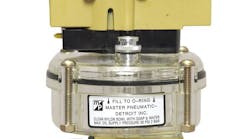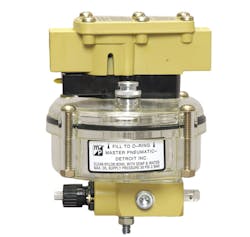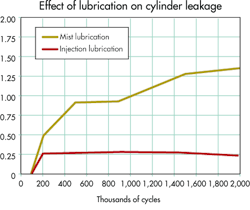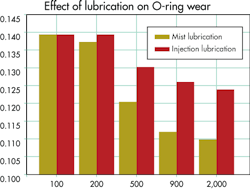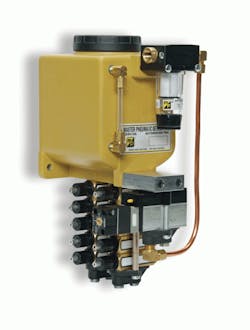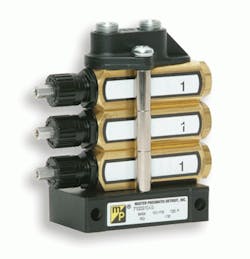Minimal Lubrication, Maximum Life
This file type includes high-resolution graphics and schematics when applicable.
Despite all of today’s hype about “oilless” pneumatics, the fact remains that many pneumatic systems and almost all pneumatic tools perform better when lubricated with oil. Using air-line lubricators to introduce oil into the airstream can continuously lubricate valves, cylinders, and air motors. Benefits include lower friction; cooler, smoother, and quieter operation; better control of speed and torque; lower maintenance and replacement costs; and longer service life.
One important design consideration is properly positioning a lubricator in the pipeline, so just the right amount of lubricant reaches each device. Too little oil permits excessive wear and leads to premature failure. Too much oil in the pipeline is wasteful and can degrade equipment performance. It also gets carried out of tools and valves in the exhaust air, where it becomes a contaminant in the ambient air and an environmental pollutant.
Intermittent lubrication may be the worst condition of all because the oil film can dry out and form sludge or varnish on the internal surfaces of equipment. Thus, lubricators should be adjusted to use the minimum amount of oil necessary to continuously lubricate equipment.
Specifying the right lubricator is also an important design factor. They come in two general types: mist lubricators and single-point lubricators. Selecting the right one for a job depends on the air system and application requirements.
Mist lubricators
Mist lubricators are designed to introduce oil into the air line and adequately lubricate downstream mechanisms. Master Pneumatic makes two different versions: sight-feed and wick-feed.
In sight-feed lubricators, air flows through a flexible vane that creates a small pressure differential between the air passage and oil reservoir. This differential causes oil to travel up a riser tube, through an adjustable metering valve, and then drip into a transparent dome and the air stream. Oil is atomized by the air stream and carried to the points of lubrication.
Sight-feed lubricators are easy to adjust, and an indicator on the sight dome measures the amount of oil dispensed. The adjusting knob can be removed to make the lubricator tamper resistant. All working parts come in an easily replaceable cartridge. However, they are not recommended for valve and cylinder circuits.
In a wick-feed lubricator, one end of a porous bronze wick is saturated with oil in the reservoir. Capillary action causes the oil to travel up the wick. Airflow strips oil off the upper portion of the wick and maintains a constant oil-to-air ratio. This ratio can be varied by manual adjustment. Units operate even with dirt and moisture in the reservoir. However, compressed air must be shut off when filling the reservoirs of these models.
A mist lubricator is suitable where it is close to the device to be lubricated; and there is a straight pipe run to the tool with no other devices in between. If this is not the case, the atomized oil that exits the lubricator accumulates on the wall of the hose or tube; at any bend in the circuit; and at any device between the mist lubricator and the air tool. Intermittent slugs of oil will find their way to the tool, which negatively impacts performance. At this point, the operator will usually turn down (or turn off) a mist lubricator. Tool manufacturers agree that their devices operate best when they consistently receive the right amount of oil. Too much or too little hurts tool performance and life.
Single-point lubricators
Single-point lubricators (SPLs) are for precision lubrication of pneumatic equipment. They eliminate the over and underlubrication problems associated with mist lubricators. SPLs consistently deliver the correct amount of oil, precisely where it is needed. For example, they ensure proper lubrication of pneumatic components in complex circuits, and in devices a long distance from lubricator.
Cylinder lubrication: Mist versus injection
A test conducted for a major automotive plant compared the effectiveness of mist-type and injection-type lubricators. The test used special dual-lip piston weld cylinders, and was conducted over three and a half months. Cylinders were run for approximately 14 hr at a time. Both types of lubricators were adjusted to dispense the equivalent of one-tenth of a drop of oil every 10 cylinder cycles.
Compressed air filtered to 0.3 μm was used in this test — a much-finer level than typical of most air-cylinder operations, where 40-μm filtration is common. When the cylinders were disassembled at the end of the test, no visible foreign particles were evident.
At the end of each daily test run, technicians attached an airflow meter to the cylinders to measure rod-end leakage while the cylinders were still warm. Cylinder leakage was gauged at regular intervals up to 2 million cycles, the end point for the entire test. Air bypass around the piston was significantly greater with mist type lubrication. Bypass leakage increased to nearly 1 scfm soon after the test began and eventually reached about 1.35 scfm. This bypass is a failure that directly affects a cylinder’s force and speed.
With injection lubrication, bypass losses were much smaller. After establishing a low initial loss level of about 0.25 scfm, it remained essentially constant for the duration of the test.
Cylinder wear during this test is exemplified by O-ring wear. An initial O-ring thickness of 0.139 in. was reduced by little more than 10% after 2 million cycles using injection lubrication. With mist lubrication, O-ring wear was nearly twice as great.
If the cylinders had been of conventional construction, and had run on air filtered to 40 μm, cylinder wear could be expected to be much greater than that recorded in this test.
Injection lubrication guarantees that lubricant reaches the cylinder at the rod end. In this case, oil was carried from the injector to the lubrication point by a small nylon tube inside the air line. The rod, therefore, was well lubricated. And, due to the piston’s extended resting period (usually directly under the retract air supply port), the piston also received a beneficial delivery of lubricant.
The longer and more tortuous the air pathway from control valve to cylinder, the less effective a mist lubricator becomes. Oil tends to coalesce on the air line walls and puddle in low points. Much of the oil can also be blown into the atmosphere from the valve’s exhaust port, so that it serves no purpose in lubricating the cylinder but, instead, creates a health hazard.
Precision oil injectors (we call them Servo-Meters) are at the heart of SPLs. They are positive-displacement, liquid injectors actuated by an air pressure signal of at least 60 psig (4 bar). In Servo-Meters, a 1/8-in. nylon line carries injected oil to the lubrication point. Ball check valves ensure that the line remains full of oil and free of air. A sight indicator with a flow-actuated ball gives visual verification of oil delivery.
The injectors come in three capacities, providing maximum flow per cycle of ½, 1, or 2 drops (1 drop = 1/30 cc). Output is adjustable and can be reduced in increments of 1/46th of rated capacity, permitting outputs as small as 1/100th of a drop. With the aid of pulse counters and controllers, lubrication can be further reduced by adjusting the frequency of oil injection — from every cycle to every tenth cycle or less.
Two options
Master Pneumatic makes two types of single-point lubricators. One is specifically designed for air tools. The other, installed downstream of a control valve, lubricates cylinders, air motors, and other pneumatic equipment.
Air-tool SPL. This unit mounts in the air supply line upstream of an air tool. When the tool cycles, the SPL injects a precise quantity of oil at the tool’s air inlet. Users can adjust both the amount and frequency of injection.
Four subassemblies make up the SPL: a flow valve, pulse counter, Servo-Meter injector, and reservoir. The air-supply line connects to the inlet of the flow valve. When the tool is idle, no air passes through the valve. Triggering the tool creates a pressure differential across a sensing disk and opens a passage to the pulse counter.
The pulse counter, in turn, receives an air signal from the flow valve. A three-position switch on the counter is set to transmit the air signal to the injector every cycle, every fifth cycle, or every tenth cycle. The air-actuated Servo-Meter then delivers a precise amount of oil to the nozzle in the outlet port of the flow valve, and it is carried by the nylon line to the air tool.
Finally, the SPL has an integral, transparent-nylon oil reservoir. Capacity is 10 oz (300 ml). It has a quick-fill cap and, because the reservoir is not pressurized, can be filled at any time without shutting down the system. SPLs can also be ordered without a reservoir, for use with a central-fill system.
Downstream SPL. Downstream injection lubricators are specifically designed to overcome the shortcomings of conventional mist lubricators. Laboratory and field tests have shown that mist lubricators installed in a conventional manner — upstream from control valves — result in much of the lubricating oil being vented to the atmosphere through the control-valve exhaust port. Oil that passes through the valve tends to coalesce and cling to the wall of the air line where it simply moves back and forth with each valve cycle.
A downstream injection lubricator, on the other hand, is installed downstream of the control valve and eliminates these concerns. Like the SPL for air tools, the downstream lubricator has a pulse counter, Servo-Meter injector, and reservoir. But an air chamber replaces the flow valve. The air line supplying the cylinder (or other device) connects to the inlet port of the air chamber. Actuating the control valve sends an air signal from the air chamber to the pulse counter, and on to the injector. Nylon tubing carries oil from the SPL’s outlet port to a point near the cylinder port. A check valve can be installed at the end of the tubing to prevent air from entering the system.
When to use an SPL
If any of the following situations apply, users can reap long-term dividends with SPLs.
- Air tools require frequent repair because vanes are worn and cylinders and rotors are scored due to insufficient lubrication.
- Lubrication fog or mist is a hazard in the plant.
- Overlubrication is expensive because of stringent requirements for disposing of used lubricants.
- Air cylinders become sluggish because of fouling with varnish or other contaminants.
- Torque in air tools varies and is difficult to control.
- Pressure regulators must be set higher than the work requires just to overcome stiction in valves, cylinders, and other air components.
- Failure of one pump in the lubrication system adversely affects the performance of the other pumps.
- Unauthorized personnel sometimes turn off lubricators or tamper with lubrication adjustments. Such actions remove lubrication control from the proper hands.
- It’s advantageous to know exactly how much lubricant is consumed, and when to refill lubricator reservoirs.
FOR MORE information on Master Pneumatic lubricators, visit www.masterpneumatic.com.
